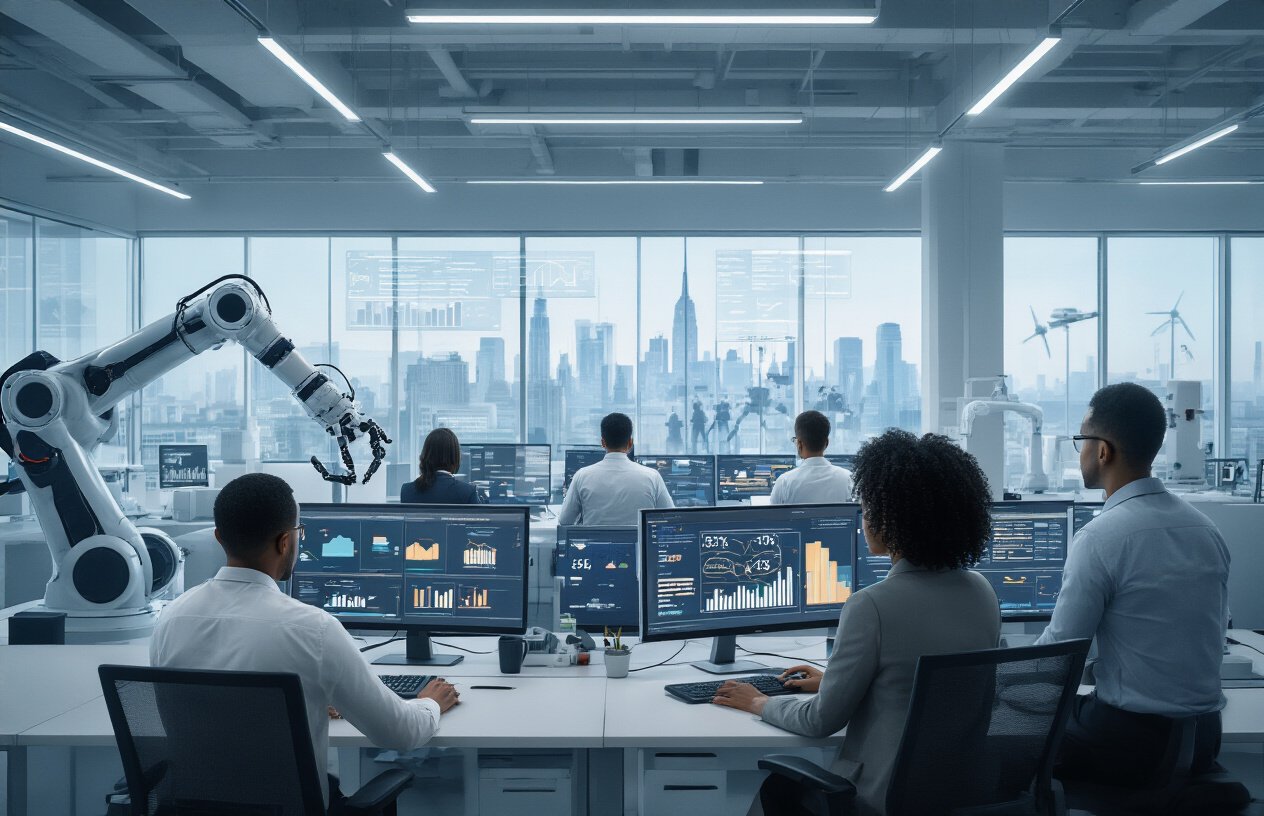Artificial intelligence and automation are reshaping America’s job market at an unprecedented pace, leaving millions of workers wondering about their career security. Will AI replace humans in the workforce? The answer is more nuanced than most expect.
This analysis is designed for American workers, business leaders, and policymakers who need to understand AI’s real impact on employment and prepare for the changing landscape ahead.
Recent research reveals that over 30% of workers could see half their job tasks disrupted by AI technology. Unlike previous automation waves that primarily affected manufacturing and routine work, today’s AI targets cognitive tasks across middle and high-paying professions. Yet the complete story involves both displacement and transformation.
The following examination covers the scale and scope of AI’s impact on American jobs, identifying which positions remain protected from automation and which face the highest risk of replacement. The discussion also explores jobs that will evolve rather than disappear, along with strategic preparation methods and essential career protection strategies for navigating this technological shift.
Understanding these dynamics helps workers make informed decisions about upskilling for the future while enabling businesses to plan workforce changes responsibly. The future of work in America depends on proactive preparation rather than reactive responses to technological advancement.
The Scale and Scope of AI’s Impact on American Jobs

Over 30% of workers face potential job disruption from AI technology
The American workforce stands at a critical juncture as artificial intelligence technology rapidly advances across industries. Current research indicates that more than 30% of all workers could experience at least 50% of their occupation’s tasks being disrupted by generative AI. This staggering statistic represents one of the most significant workforce transformations in modern American history, affecting millions of employees across diverse sectors.
The scale of this disruption extends far beyond traditional automation patterns, creating an unprecedented challenge for the American economy. Unlike previous technological shifts that occurred gradually over decades, AI’s impact on the future of work in America is accelerating at an extraordinary pace. This rapid transformation leaves little time for workers and organizations to adapt, making strategic workforce planning more crucial than ever.
The breadth of AI’s reach means that virtually no industry remains untouched by automation potential. From healthcare and finance to education and creative services, generative AI technologies are demonstrating capabilities that were previously thought to be uniquely human domains.
Cognitive and non-routine tasks now at risk unlike previous automation waves
A fundamental shift distinguishes current AI advancement from historical automation trends. Unlike previous automation technologies that primarily affected routine, blue-collar work, generative AI is likely to disrupt a different array of “cognitive” and “nonroutine” tasks. This represents a paradigm change in how technology and jobs intersect within the American workforce.
Traditional automation focused on repetitive, manual processes that could be easily replicated by machines. Factory assembly lines, data entry positions, and basic customer service roles were among the first to experience technological displacement. However, AI and automation now target complex problem-solving activities, creative processes, and analytical work that require human judgment and expertise.
This evolution means that professionals who previously considered their positions secure due to the intellectual demands of their work must now reassess their career trajectories. The cognitive tasks that define many modern professions—including analysis, writing, research, and strategic planning—are increasingly within AI’s capabilities.
Middle to higher-paid professions face unprecedented vulnerability
Perhaps most surprisingly, middle- to higher-paid professions are especially vulnerable to AI disruption. This trend challenges conventional wisdom about which workers face the greatest risk from technological advancement. Historically, lower-wage positions were considered most susceptible to automation, but AI’s sophisticated capabilities have inverted this expectation.
Professional roles requiring advanced education and specialized training now find themselves at the forefront of potential disruption. Legal research, financial analysis, medical diagnosis assistance, and content creation represent areas where AI demonstrates remarkable proficiency. These positions, traditionally offering job security and competitive compensation, must now contend with machine learning systems that can process information, identify patterns, and generate outputs with increasing accuracy and speed.
The economic implications extend beyond individual career concerns to broader questions about income distribution and social mobility in America. As higher-paying cognitive work becomes susceptible to automation, the traditional pathway to economic advancement through education and skill development faces significant challenges. This shift requires fundamental reconsideration of how the American workforce prepares for technological change and ensures continued human relevance in an AI-driven economy.
Jobs That Remain Safe from AI Automation

Physical trades requiring dexterity and human judgment
Physical trades represent one of the most secure employment categories in the face of advancing AI and automation technologies. Coast Guard rescue swimmers, firefighters, and skilled craftspeople involved in tasks such as plumbing repairs, culinary preparation, or construction projects remain fundamentally protected due to their reliance on human dexterity, rapid decision-making capabilities, and physical exertion requirements.
The barriers preventing AI replacement in these sectors extend beyond technological limitations to encompass economic and trust factors. Robotics technology continues to face significant challenges in cost-effectiveness, reliability, and public acceptance when applied to complex physical tasks that require split-second judgment calls and adaptability to unpredictable environments.
While AI may serve as an augmentative tool in these professions—such as firefighters utilizing vision-enabled helmets for enhanced situational awareness—the technology cannot replace the inherently human aspects of these roles. The combination of physical capability, environmental awareness, and critical thinking required in trades work creates a protective barrier against automation that will likely persist well into the future of work in America.
Healthcare roles demanding empathy and regulatory compliance
Healthcare and social services professions maintain strong protection against AI replacement due to their fundamental requirement for human connection and emotional intelligence. Therapists, doctors, coaches, and teachers occupy roles that center on imparting knowledge, providing encouragement, sharing wisdom, and demonstrating empathy—capabilities that current AI technology cannot authentically replicate.
Surgeons benefit from additional layers of protection through regulatory and financial considerations within the American healthcare system. Insurance companies demonstrate greater comfort in providing coverage for procedures performed by human practitioners compared to robotics or AI-enabled surgical systems. This preference stems from established trust relationships, proven track records, and existing liability frameworks that favor human expertise over emerging automated alternatives.
The interpersonal nature of healthcare delivery ensures that these roles remain centered on human-to-human interaction, where trust, compassion, and nuanced understanding of individual patient needs continue to be irreplaceable human qualities.
Legal professions protected by licensing and trust requirements
Legal professions, particularly attorneys, maintain robust protection against AI replacement through regulatory frameworks that ensure human advocates remain central to the justice system. The requirement to pass the bar examination and maintain professional licensing creates institutional barriers that preserve human involvement in legal proceedings and client representation.
The legal profession’s emphasis on advocacy, judgment, and ethical reasoning requires human practitioners who can navigate complex moral and procedural considerations while maintaining client trust and confidentiality. However, support roles within the legal field, such as paralegals, may experience greater exposure to automation as routine research and document preparation tasks become increasingly susceptible to AI-driven efficiency improvements.
This regulatory protection, combined with the profession’s emphasis on human judgment and client relationships, positions attorneys among the most secure professional categories in discussions about AI and automation’s impact on the American workforce.
High-Risk Positions Vulnerable to AI Replacement

Knowledge work involving repetitive and routine tasks
Positions centered on routine knowledge work face the highest vulnerability to AI replacement in America’s workforce. These roles typically involve highly repetitive tasks that do not require specialized domain expertise or advanced analytical thinking. The predictable nature of such work makes it particularly suitable for AI automation, as machine learning systems excel at pattern recognition and task replication.
Jobs in this category often involve data processing, basic analysis, and administrative functions that follow established protocols. The lack of creative problem-solving or nuanced decision-making requirements positions these roles as prime candidates for technological displacement. Organizations increasingly recognize that AI systems can perform these tasks with greater consistency, speed, and cost-effectiveness than human workers.
Roles that can be performed instantaneously without physical presence
The future of work in America reveals particular vulnerability among positions that operate without physical constraints. Jobs that can be executed instantaneously or continuously without physical exertion represent a significant risk category for AI replacement. These roles benefit from digital infrastructure that allows seamless automation integration.
Transcription services exemplify this vulnerability, as AI systems now demonstrate remarkable accuracy in converting speech to text in real-time. Similarly, scheduling functions and calendar management can be performed by AI systems that operate continuously without breaks or physical limitations. The instantaneous nature of these digital tasks eliminates traditional barriers that previously protected human workers from technological displacement.
Support functions where efficiency outweighs human interaction
Support functions across American industries face transformation as organizations prioritize operational efficiency over traditional human touchpoints. AI captioning systems and automated avatars increasingly replace live note-takers and interpreters in scenarios where accuracy and speed take precedence over personal interaction.
This shift particularly impacts administrative support roles where efficiency metrics drive decision-making. The technology and jobs landscape shows that when organizations can achieve faster turnaround times and reduced operational costs through automation, human workers in these support functions become expendable.
The ripple effects extend beyond direct replacement scenarios. Recruiting roles may experience reduced demand not through direct AI substitution, but because AI augments overall worker productivity. As fewer critical job openings emerge due to enhanced efficiency, the need for recruiters to fill non-essential positions diminishes, creating indirect workforce impacts across the American economy.
Jobs That Will Transform Rather Than Disappear

Roles that will partner with AI rather than compete against it
The future of work in America increasingly points toward collaboration between humans and artificial intelligence systems. Rather than viewing AI as a replacement threat, many positions will evolve to leverage AI capabilities while maintaining essential human elements. Workers who focus their careers on solving real-world problems by partnering with AI rather than competing against it will find themselves in transformed but secure roles.
This collaborative approach represents a fundamental shift in how technology and jobs intersect within the American economy. The key lies in understanding that AI excels at data processing and pattern recognition, while humans provide critical thinking, emotional intelligence, and complex problem-solving capabilities that remain irreplaceable.
Technical positions that require human oversight and interaction
Healthcare technology roles exemplify how human expertise remains vital even as AI advances. Radiology technicians demonstrate this evolution perfectly – these professionals will continue to be essential for patient interaction during MRI scans, providing comfort, ensuring proper positioning, and managing the human aspects of medical procedures. While AI streamlines diagnostics and improves processes, the need for human oversight and patient care ensures these roles persist, though potentially with reduced overall numbers of technicians required.
The transformation of these technical positions highlights how AI and automation enhance rather than eliminate human capabilities. Medical professionals must interpret AI-generated insights within the context of patient care, making decisions that require empathy, communication skills, and clinical judgment that technology cannot replicate.
Industries awaiting technological maturity before full automation
Several industries currently maintain stability while technology develops toward eventual automation. Truck driving and cargo handling represent prime examples of sectors that remain relatively safe in the near term but face potential disruption as technology matures. These roles could become endangered once autonomous fleets prove safer than human drivers and adoption accelerates as costs and risks favor technology over human operators.
The timeline for full automation in these industries depends on technological advancement, regulatory approval, and economic factors. Until autonomous systems demonstrate consistent superiority in safety and efficiency, human workers maintain their positions while gradually adapting to increasingly automated environments.
Strategic Preparation for Workforce Changes

Worker Engagement in AI Design and Implementation Processes
Strategic preparation for the future of work in America requires fostering meaningful worker engagement throughout AI design and implementation processes. Organizations that prioritize workforce involvement in technology deployment create more effective systems while reducing resistance to change. This collaborative approach ensures that AI solutions address real workplace challenges rather than imposing theoretical improvements that may not align with operational realities.
Workers possess invaluable insights into daily processes, potential inefficiencies, and practical applications of emerging technologies. Their direct involvement in AI development phases helps identify which tasks benefit most from automation versus those requiring human expertise. This engagement also facilitates smoother transitions as employees become stakeholders in technological advancement rather than passive recipients of change.
Successful worker engagement initiatives include cross-functional teams that bring together technical specialists and frontline employees. These collaborative structures enable continuous feedback loops, allowing organizations to refine AI implementations based on practical experience and worker concerns.
Enhanced Worker Voice Through Unions and Advocacy
Enhancing worker voice through unions and advocacy organizations represents a crucial component of strategic workforce preparation. As AI and automation reshape the American economy, collective representation becomes increasingly important for protecting worker interests and ensuring fair transitions.
Labor unions play a vital role in negotiating agreements that address AI implementation timelines, retraining opportunities, and job security provisions. These organizations can advocate for transparent communication about technological changes, giving workers advance notice of planned automation initiatives. Union involvement also helps establish frameworks for sharing productivity gains from AI adoption, ensuring that workers benefit from technological improvements rather than bearing solely the costs of displacement.
Professional associations and advocacy groups complement union efforts by providing platforms for workers to influence industry standards and best practices. These organizations can push for ethical AI development that considers human impact alongside efficiency gains. Through collective action, workers gain leverage to shape how technology integrates into their industries.
Public Policies Ensuring Workers Benefit from AI Advancement
Developing comprehensive public policies that ensure workers benefit from AI advancements while mitigating potential harms represents a fundamental requirement for successful workforce transformation. Effective policy frameworks must address both immediate concerns like job displacement and long-term considerations such as inequality and skills gaps.
Policy initiatives should focus on creating safety nets for displaced workers, including extended unemployment benefits, healthcare continuity, and career transition support. Investment in workforce retraining programs enables workers to develop skills aligned with emerging opportunities in the technology-enhanced economy. These programs must be accessible, relevant, and responsive to rapidly changing industry needs.
Tax policies can incentivize companies to invest in worker development rather than pursuing automation solely for cost reduction. Revenue generated from AI-driven productivity gains could fund universal basic income pilots or expanded education programs. Regulatory frameworks should also establish standards for responsible AI deployment that considers workforce impact alongside technological capabilities.
Strategic coordination between federal, state, and local governments ensures consistent support for workers navigating technological change. These policies create an environment where AI advancement contributes to shared prosperity rather than exacerbating existing inequalities in American society.
Essential Career Protection Strategies

Focus on roles requiring human trust and accountability
With the workforce landscape evolving rapidly due to AI and automation, professionals must strategically position themselves in roles where human elements remain irreplaceable. Fields such as law, medicine, public safety, and skilled trades continue to demand the unique combination of trust, accountability, and physical presence that only humans can provide.
The legal profession exemplifies this principle, where clients require direct human interaction to navigate complex legal matters. The accountability inherent in legal representation cannot be delegated to automated systems, as the consequences of legal decisions carry real-world implications that demand human judgment and responsibility. Similarly, healthcare professionals maintain their critical role in the American economy precisely because patients need the assurance of human care, empathy, and medical accountability that technology cannot replicate.
Public safety roles, including law enforcement and emergency response, represent another category where human trust remains paramount. These positions require split-second decision-making in unpredictable situations, combined with the physical presence necessary to protect and serve communities effectively.
Skilled trades offer additional protection against automation, as these roles typically involve complex problem-solving in variable environments, manual dexterity, and the ability to adapt to unique site conditions that challenge current AI capabilities.
Develop skills in areas needing regulatory compliance
The future of work in America increasingly favors professionals who understand and navigate regulatory frameworks. Industries requiring strict compliance standards create natural barriers to full automation, as regulatory bodies typically require human oversight and accountability in critical processes.
Financial services, healthcare administration, environmental management, and safety inspection roles exemplify areas where regulatory compliance creates job security. These sectors demand professionals who can interpret complex regulations, ensure adherence to evolving standards, and maintain the documentation trails that regulators require.
Technology and jobs intersect uniquely in compliance-heavy industries, where AI tools may assist in data analysis and pattern recognition, but human expertise remains essential for interpreting regulations, making judgment calls, and accepting responsibility for compliance decisions. This dynamic creates opportunities for upskilling for the future, as professionals can combine their regulatory knowledge with AI literacy to enhance their value proposition.
The American economy’s regulatory landscape continues to expand, particularly in emerging technology sectors, creating ongoing demand for professionals who can bridge the gap between innovation and compliance requirements.
Build expertise in problem-solving rather than specific functions
Now that the importance of trust-based roles and regulatory expertise has been established, the most crucial career protection strategy involves developing broad problem-solving capabilities rather than narrow functional specialization. This approach enables professionals to partner with AI systems rather than compete against them.
Workers who focus on solving real-world problems demonstrate adaptability that transcends specific job functions or technological disruptions. This strategy recognizes that while AI excels at automating routine tasks and analyzing data patterns, complex problem-solving often requires the synthesis of multiple disciplines, creative thinking, and the ability to navigate ambiguous situations.
The human vs machine dynamic shifts significantly when professionals position themselves as problem-solvers who can leverage AI tools as part of their solution toolkit. Rather than viewing automation as a threat, these individuals use technology to enhance their problem-solving capacity while maintaining their role as the strategic decision-makers.
Workforce retraining programs increasingly emphasize this approach, encouraging professionals to develop systems thinking, cross-functional knowledge, and the ability to translate between technical capabilities and business needs. This skill set remains valuable across industries and adapts well to changing technological landscapes.
Building problem-solving expertise also involves developing meta-skills such as learning how to learn, adapting to new tools quickly, and understanding how to integrate diverse information sources into actionable solutions that serve human needs and organizational objectives.

The AI revolution is reshaping America’s workforce in unprecedented ways, with more than 30% of workers potentially seeing at least half of their job tasks disrupted by generative AI technology. Unlike previous automation waves that primarily affected blue-collar positions, this transformation targets cognitive and nonroutine tasks across middle- to higher-paid professions. Jobs requiring empathy, physical dexterity, regulatory compliance, and human judgment—such as healthcare, skilled trades, emergency services, and law—remain largely protected, while repetitive knowledge work faces significant displacement risk.
The path forward demands strategic preparation and proactive planning from both workers and employers. Companies must begin categorizing their workforce needs for the coming years, determining which roles require irreplaceable human presence and which can be enhanced or replaced by technology. Workers should focus their careers on solving real-world problems rather than performing specific functions, positioning themselves as partners to AI rather than competitors. The organizations that thrive will be those that foster worker engagement in AI implementation, enhance employee voice, and develop policies ensuring that technological advancement benefits the workforce while mitigating potential harms. The time to prepare for this transformation is now, before technology advances further and opportunities for strategic adaptation diminish.



